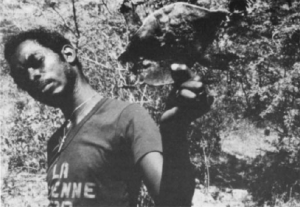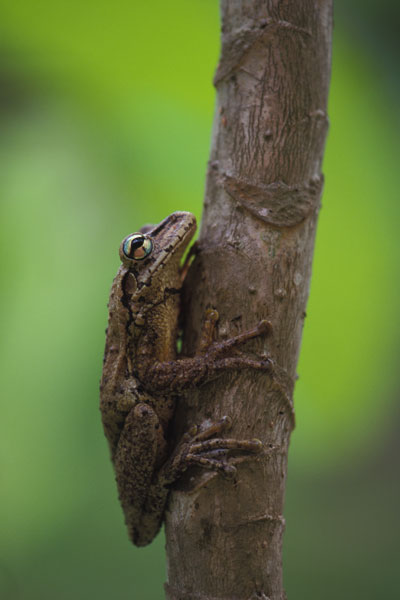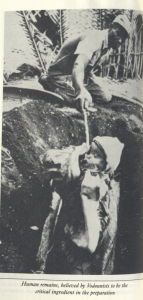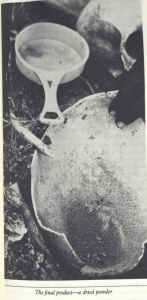Is zombification a practice achieved through bokor’s vodou and ritual or through the powerful effects of certain drugs?
“The first problem is to know when the dead are truly dead”
-Dr. Nathan Kline
As usual, Kline was on the search for new drugs with medical potential and his hunt expanded even to Haiti. In 1981, he was contacted by the Haitian-born, Canadian-trained psychiatrist Dr. Lamarque Douyon who headed the Mars and Kline Centre de Psychiatrie et Neurologie in Port-au-Prince and recorded all reports of zombies since 1961 (Platt 139). Douyon believed zombies were real, but thought that victims were made to look dead using a drug that dramatically slowed metabolism. He hypothesized that after being drugged, the victim was buried, dug up within a few hours, and then reawakened somehow. However, it wasn’t until 1981 when he heard of the story of Narcisse coming back as a zombi that he had some evidence to support his hypothesis. Their next step was to find the formula for the poison.
The Narcisse rumors and stories provided scientists with the most potential proof for Haitian zombies at the time, and consequently were the motivation for the Zombie Project. This project was a study of the origins of zombies conducted in Haiti between 1982 and 1984. During that time, ethnobotanist and anthropologist Dr. Wade Davis traveled through Haiti at the request of Dr. Nathan S. Kline with the motivation to discover what causes Haitian zombies.
Video – Wade Davis on Haitian Zombis: Wade Davis – Looking For Haitian Zombies

Dr. Nathan Kline theorized that a drug was responsible for Narcisse’s stories as a zombie, one with the power to dramatically lower metabolism. With hopes that the discovery of this drug would lead to unique medical uses (especially in the field of anesthesiology), Kline planned to gather samples of these drugs, analyze them, and figure out how they worked in the body and on the mind.
During his research in Haiti, Davis observed and even took part in vodou secret society ceremonies. He was even able to obtain the formula for the mixture within two week on one of his visits and bring it back to Kline. In one of his personal recollections of this project, Davis explained:
“[What we learned was that] the poison has nothing to do with making zombies. A zombie is someone who by definition has his soul stolen by sorcery. To make a zombie, you capture the soul and that is what flings a person into perpetual purgatory. And that is essentially black magic. But it turns out that a very effective time to capture someone’s soul is when the soul and the physical body dissociate at the time of death. And so, in Haiti, there are two kinds of death: natural deaths and unnatural deaths. The poison is a useful way of inducing unnatural death when the negative priests can do their work” (Platt 143).
He discovered that Haitians believed that a bokor’s sorcery created zombies by capturing a victim’s ti bon ange – which is the part of the soul directly connected to an individual – rather than believing zombies were solely caused by the effects of a poison or drug. However, when he learned that the bokor did use complex powders in their vodou zombification rituals, Davis set off and collected eight samples of this zombie powder in four different regions of Haiti (Wilson). The ingredients in each of these samples were not exactly the same. After analyzing these samples, he discovered that seven of the eight samples had four ingredients in common…
Zombie Powder ingredients:
1. One or more species of puffer fish (Diodon hystrix; Diodon holacanthus; Sphoeroides testudineus) — often containing a deadly neurotoxin called tetrodotoxin that induces a state of complete peripheral paralysis, extremely low metabolic levels, and retention of compete consciousness

2. A marine toad (Bufo marinus) — also produces numerous toxic substances that have pain killing effects and can potentially kill; the toad’s venom’s three main components are biogenic amines, bufogenine, and bufotoxins



3. A hyla tree frog (Osteopilus dominicensis) — secretes an irritating (but not deadly) substance

4. Human remains

Additionally, the zombie powders contained a variety of other animal and plant ingredients (including Jimsons Weed (Datura stramonium), spiders, lizards, and ground glass), which likely would have irritated the skin, had hallucinogenic effects, or were poisonous.


Davis was especially fascinated by the use of the puffer fish and the drug tetrodotoxin, which blocks the sodium channels between nerve endings. This powerful nonprotein poison causes a drop in temperature and blood pressure, paralysis, coma, and possibly even death. Its painkilling effects are 160,000 times stronger than cocaine. Victims of tetrodotoxin poisoning often remain conscious but paralyzed until just before death (Wilson). Consequently, it prevents the victims from reacting to stimuli, which is similar to Clairvius Narcisse’s experiences before becoming a zombi. Even other doctors had documented cases of people who ingested tetrodotoxin and appeared dead but later make a complete recovery. However, if the powder is too potent, it may actually kill the victim and prevent zombification.
From all his research, Davis theorized that the tetrodotoxin drug is able to pass into the bloodstream to paralyze the victim because the topically-applied powder provides passageway for the drug by causing irritation and breaks in the skin. Then, after the victim is buried, the bokor is able to remove the body from the grave. By that time, the zombie powder wears off and the victim believes himself to be a zombi. His research was complied into two books, The Serpent and the Rainbow (1985) and Passage of Darkness: The Ethnobiology of the Haitian Zombie (1988), that presented a pharmacological case for zombies.
While his theory was convincing, there were many problems in his research that led to a great deal of criticism from the scientific community because of several scientific inaccuracies. Generally, his critics claimed that his methods were unscientific and his assertions ignored contrary evidence. The controversy mostly focused on the poison tetrodotoxin in the zombie powder. Many scientists claimed that there was either no or little tetrodotoxin in the samples of zombie powder that Davis collected and they consequently accused him of withholding information because it didn’t support his claims. Bo Holmstedt of Karolinksa Institute in Stockholm stated, “It is not deliberate fraud. It is withholding negative data. It is simply bad science” (Booth 274). In further experiments with the drugs on rats and a rhesus monkey, scientists criticized the results from those studies because of the possibility that the powder was not pure and some other drug may have been added (Booth 275). Overall, there was a great deal of controversy in the results and conclusions from the Zombie Project.
Wonderful Blogpost thank you for sharing.
Hello, after reading this remarkable post i am as well happy to share my know-how here
with friends.
nice job your blog is so good